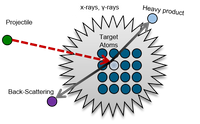TECHNOLOGY
The IAEA lists about 300 scientific ion-beam analysis labs world-wide for numerous fields and applications. The amount of different technical implementations of end-stations is even larger, although many aspects of the measurement are identical, regardless of the specific application. Identifying these key technology aspects opens up potential for improved devices and results.
Ion beam analysis relies on the physics of ion-matter interaction. This comprises a series of interdependent processes starting from the accelerated projectiles and ending in the detection of products released by the interaction of the projectiles with the sample. Upon impacting the sample, the projectiles experience an energy-loss induced mostly by collisions with the electrons attached to the sample atoms. This so-called stopping SB can be described by the Bethe-Bloch formula in the form of an energy dependent energy-loss per passed sample slice x.
The stopping directly results in a limited and fixed range which depends on projectile energy, projectile nuclear charge z, and the target electron density. Within this range several types of interactions with the sample nuclei and electrons take place as shown below. The knowledge of the projectile and product properties enables an identification of the target atom. The amount of released products per incident projectiles enables quantification of the target atoms in the sample.
The methods of Rutherford-Backscattering Spectrometry (RBS) and Nuclear Reaction Analysis (NRA) detect the charged particles emitted from the reaction of the projectiles with the sample. RBS and its high-energy pendant Elastic-Backscattering Spectrometry (EBS) consider elastic nuclear collisions where incoming and outgoing particles are identical. NRA considers inelastic nuclear reactions where the reaction products are different from the initially present nuclei. Both reaction types are typically 2-body reactions with the projectile and the sample nuclei on the input and two product nuclei on the output side. As an example we consider the reactions of protons with 7Li. This reaction either results in elastic scattering in the form of 7Li(p, p)7Li, the production of two alpha particles via 7Li(p, a)4He, or the emission of neutrons via 7Li(p, n)7Be. All reactions occur with their individual probability, therefore the emission of neutrons and the corresponding radiation dose rates are an unavoidable side-effect of the analysis (in this case).
The reactions can excite the heavy nucleus of the above mentioned reactions, which quickly decays via emission of photons. Analysing this secondary photon via particle induced gamma-ray emission spectroscopy (PIGE) yields an additional option for the target quantification not relying on the short-ranged charged products. These photons have typical energies between 0.2 and 4 MeV, enabling an analysis even through vacuum chamber walls or the sample itself. Besides nuclear interactions, also interactions with the electrons bound to the atoms take place. The projectiles can removed bound electrons from inner shell positions. The subsequent inner conversion emits x-rays with characteristic energies in the order of 1-80 keV, which can be analysed via Particle Induced X-ray Emission Spectroscopy (PIXE). The physics of PIXE is identical to the electron microscopy equivalent EDX, but due to the higher ion mass, the Bremsstrahlung background reduces and the detection limits improve substantially.
The considered reactions emit their products in all directions (4pi). Detectors can only catch a part of these products, typically in the order of 1% due to technical and geometrical restrictions. The solid angle (measured in steradian) states the detector extent relevant for the data analysis. Using a larger detector or bringing the detector closer to the sample increases the solid angle. On the downside this also blur the detector geometry and increases the importance of mechanical tolerances and alignment which are both important for defining the reaction kinematics.
